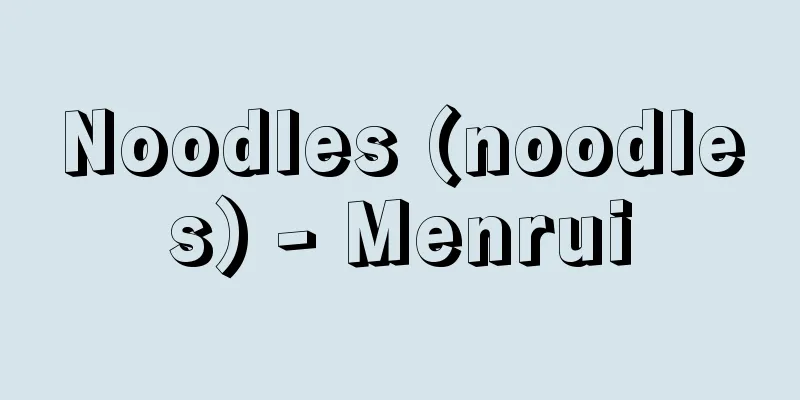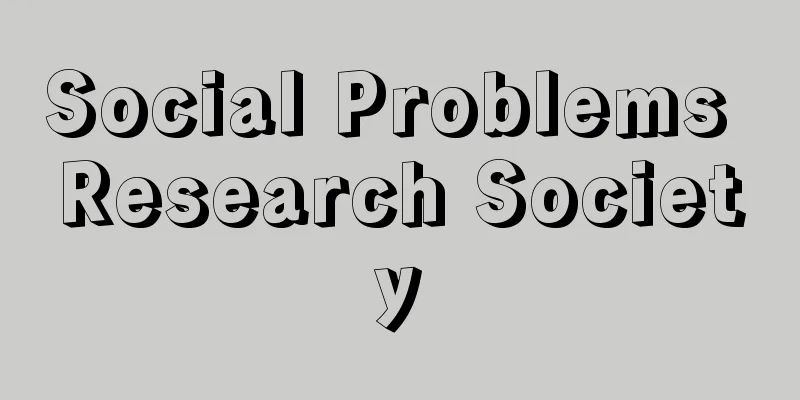Han Chinese - Kanminzoku (English spelling)

|
They consider the Central Plains region of the middle and lower reaches of the Yellow River in China to be their homeland, and have also migrated to coastal islands and the northeastern region, living overseas, particularly in Southeast Asia, as Chinese nationals of Chinese origin and Chinese of other nationalities who have migrated to various parts of the world. They are the world's most populous ethnic group. They are also called the Han people or Han people. China's population is said to be over 1.3 billion, of which the Han people account for approximately 92% (2010 census). [Yoshio Watanabe] Ethnic groups and languagesThe Han people are said to have been formed around the 10th century BC, when a tribe called Zhou migrated from northwestern Central Asia to the Central Plains and settled there, gradually integrating the surrounding tribes. The concept of "ethnic group" is a category that was first recognized under the influence of modern Europe, so of course the Han people did not exist in the Zhou dynasty. It was only after the First Sino-Japanese War that the Han people were recognized as an ethnic group, and they were aware of their identity in relation to the ethnic minorities in China. Therefore, it can be said that the Han people that was formed in modern times was formed by the fusion of various groups over the previous 3,000 years. The language of Chinese was adopted as the common language from Beijing Mandarin after the concept of the Han people was established. Chinese belongs to the Sino-Tibetan language family and has branched out into many dialects. However, the characters that were used from the oracle bone script that was used about 3,300 years ago have been used continuously under the name of "Chinese characters", and they have been useful for national unification and have been consolidated and abolished. With the establishment of the Han people, Chinese characters came to be considered the unique writing system of the Han people. [Yoshio Watanabe] Agricultural CultureAs known by the name "Peking Man," humans have been living in China since the Early Paleolithic period. The Han people have consciously sought the origins of their culture in the Neolithic agricultural culture of the Yellow River basin, even though there was a similarly ancient agricultural culture in the Yangtze River basin. According to their historical understanding, they developed a unique culture with local color through the process of incorporating surrounding groups, especially other tribes south of the Yangtze River basin, from their original homeland in northern China. The majority of Han people are settled intensive farmers who practice irrigated farming. In northern China, field crops such as wheat, foxtail millet, sorghum, and corn, as well as potatoes, are the main crops cultivated, while in central and southern China, paddy rice and sweet potatoes are cultivated. This diversity of cultivated crops, combined with advanced culinary techniques, has produced Chinese cuisine with a strong regional flavor. In terms of housing, while most people in the northeast and northern China have single-story brick or earthen houses designed to protect against the cold, most people in central and southern China have two-story wooden houses with an emphasis on protection from heat and moisture, and a lifestyle that is suited to the environment can be seen. [Yoshio Watanabe] Society and religionHan Chinese society has traditionally been based on patrilineal descent groups. Children take their father's surname, and wives keep their birth surname even after marriage. Monogamy and residence at the husband's side are the norm, but there is a principle that men and women with the same surname cannot marry. A clan of the same ancestry and surname is called a "sozoku" (lineage), and worships their common ancestor in an altar, with the clan leader controlling hundreds or thousands of clan members. The Han Chinese have three religions, Confucianism, Buddhism, and Taoism, or five if Islam and Christianity are added, but the core religion is a folk religion of "respect for heaven and ancestors." The gods they worship include the supreme god Yufan Shanti, as well as many other functional gods, who are the object of people's worldly benefits. In addition, ancestor worship is the religious foundation of Han Chinese society, and prayer and incantations to ward off evil spirits are also essential to religious life. These Han Chinese social and religious traditions have undergone many changes on the mainland since the founding of the People's Republic of China in 1949, but have been revived since the implementation of the Reform and Opening Up policy. [Yoshio Watanabe] "Encyclopedia of China" by Ishikawa Masaru (1981, Nihon Jitsugyo Publishing)" "World History of Ethnic Groups 5: Han People and Chinese Society" edited by Hashimoto Mantaro (1983, Yamakawa Publishing)" "Reader on Asia: China" edited by Zeng Shicai, Nishizawa Haruhiko, and Segawa Masahisa (1995, Kawade Shobo Shinsha) [Reference items] | | | |Source: Shogakukan Encyclopedia Nipponica About Encyclopedia Nipponica Information | Legend |
|
民族意識のうえで中国黄河(こうが/ホワンホー)中下流域の中原(ちゅうげん)地域を原郷と考え、沿岸諸島嶼(とうしょ)、東北地区にも移住して生活し、海外ではとくに東南アジアを中心に、中国籍の華僑(かきょう)、移住先諸国籍の華人として、世界各地に居住する世界最多人口の民族。漢族、漢人ともいう。中国国内の人口は13億人余りとされ、うち漢民族は約92%を占めるといわれている(2010年センサス)。 [渡邊欣雄] 民族と言語漢民族はおよそ紀元前10世紀ごろ、西北の中央アジアから中原地域に周という部族が移動定着し、徐々に周辺諸部族を統合していく過程で形成されたとされる。「民族」という概念は、ヨーロッパ近代の影響で初めて認識されたカテゴリーであるから、むろん周代に漢民族が存在したわけではない。漢民族が自他ともに民族として認識されたのは日清(にっしん)戦争以後であり、中国国内の少数民族との相対において自覚されたのである。したがって近代に形成された漢民族は、それ以前のおよそ3000年にわたる諸集団との融合によって形成されてきたといえる。言語の漢語は漢民族という概念の成立以後、北京(ペキン)官話を共通語として採用したものである。漢語はシナ・チベット語族に属し、多くの方言に分岐している。しかし、およそ3300年前から用いられた甲骨文字以降の文字が「漢字」の名において連綿と用いられてきており、国家統一に役だつとともに、漢字も統廃合がなされてきた。漢民族の成立とともに、漢字は漢民族固有の文字と考えられるに至る。 [渡邊欣雄] 農耕文化「北京原人」の名で知られるように、中国には前期旧石器時代以来の人類が生活していた。漢民族の母体としての文化の淵源(えんげん)は、長江(ちょうこう/チャンチヤン)(揚子江(ようすこう/ヤンツーチヤン))流域に同様の古さの農耕文化があったにもかかわらず、彼らの意識のうえで黄河流域にあった新石器時代の農耕文化に求められてきた。彼らの歴史認識によれば、以後この華北の原郷から周囲の諸集団、ことに長江流域以南の異部族を包摂していく過程を通じて、地方色のある独自の文化を発展させてきたと考えられている。 漢民族の大部分は灌漑(かんがい)農耕による集約的定着農耕民である。華北は麦、アワ、コウリャン、トウモロコシなどの畑作穀物やジャガイモを主として栽培しているのに対して、華中、華南では水稲耕作とサツマイモの栽培が盛んである。こうした栽培作物の多様性と高度の料理技術とが結合して、地方色豊かな中華料理を生み出してきた。住居も、東北地区や華北の防寒を目的としたれんが造りや土造りの平屋家屋が多いのに対し、華中、華南では防暑、防湿に重点を置いた2階建て木造家屋が多いなど、環境に即した生活様式が認められる。 [渡邊欣雄] 社会と宗教漢民族の社会は伝統的に父系出自集団がその基礎をなしている。子供は父の姓を名のり、結婚後も妻は生家の姓を保つ。一夫一婦制で夫方居住が通則であるが、同姓の男女は結婚できない同姓不婚の原則があった。同祖同姓の一族は「宗族(そうぞく)」とよばれ、祠堂(しどう)に共祖を祀(まつ)り、族長が数百、数千人の族員を統轄している。漢民族の宗教は儒教、仏教、道教の3教、あるいはこれにイスラム教、キリスト教を加えて5教とされるが、基幹宗教は「敬天崇祖」の民俗宗教である。崇拝の対象である諸神には最高神である玉皇上帝(ユーファンシャンティ)をはじめ幾多の機能神がおり、人々の現世利益(げんぜりやく)の対象となっている。また祖先崇拝は漢民族社会の宗教的根幹をなすものであり、さらに悪鬼、邪霊の防除を行う祈祷呪術(きとうじゅじゅつ)も宗教生活に欠かせない。このような漢民族の社会と宗教の伝統は、1949年の中華人民共和国成立以後、大陸では幾多の変革を受けたが、改革開放政策の実施以後復活を遂げた。 [渡邊欣雄] 『石川昌著『中国を知る事典』(1981・日本実業出版社)』▽『橋本萬太郎編『民族の世界史5 漢民族と中国社会』(1983・山川出版社)』▽『曽士才・西澤治彦・瀬川昌久編『アジア読本・中国』(1995・河出書房新社)』 [参照項目] | | | |出典 小学館 日本大百科全書(ニッポニカ)日本大百科全書(ニッポニカ)について 情報 | 凡例 |
Recommend
Kanautsugi - Kanautsugi
A deciduous shrub of the Rosaceae family (APG cla...
Hydroxylamine
[ I ] Hydroxylamine: NH2OH (33.03). It is prepare...
Station place
...While the station building was an architectura...
Yellow baboon
It is an animal of the Cercopithecidae family of ...
Sand flea
…When they come onto land, they move by jumping, ...
Rock Powder Shelf Method - Ganpun Danaho
...Also, since something that is as white as poss...
No women allowed
A sacred place prohibits women from entering any ...
Michitaka Kujo
Year of death: January 4, 1906 (Meiji 39) Year of ...
Cowri - Cucumber
…His childhood name was Fudotaro, later Mokichi. ...
Grylloblattidae yezoensis (English spelling) Grylloblattidaeyezoensis
…[Yamazaki Harane]. … *Some of the terminology th...
Typewriter - typewriter
A writing machine that creates documents by press...
Mining - Kougyou
Mining is the industry that extracts useful miner...
Iolkos (English spelling)
A city in Magnesia, ancient Greece. Located on the...
Commercial law - Shoho
The Significance of Commercial Law [1] Formal mea...
Kolingba, A. (English spelling) KolingbaA
…Immediately after the presidential election, ant...









